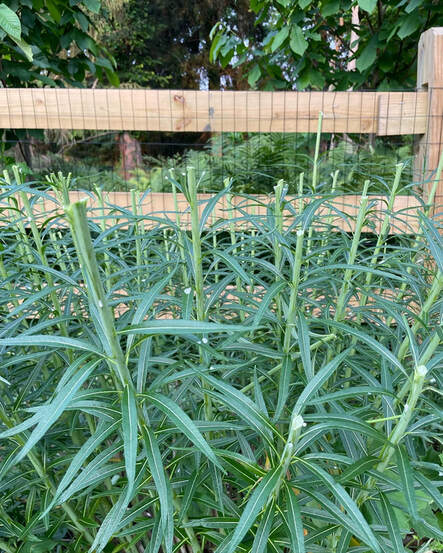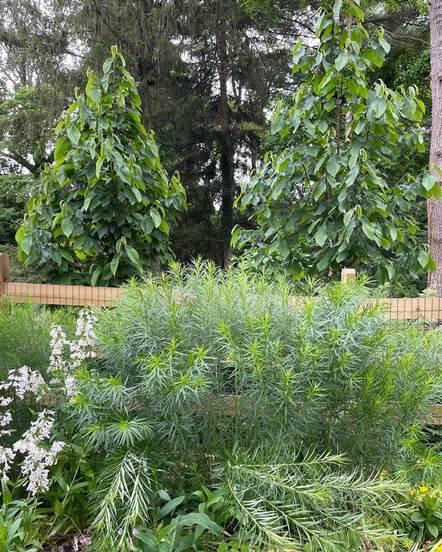Our Garden Philosophy: Through The Seasons
Spring
Spring is a magical time of emphemerals and beauty. It is also an important time for managing weeds that come up in the garden and a time for you to get an early start on planting, especially evergreen woodies.
Summer
Summer maitenance involves a wide variety of maitenance tasks from cutting back your perennials, pruning your shrubs, keeping your plants watered, trimming back seed heads, continuing to weed your garden beds, and most importanly enjoying the beauty of your plants!
Garden Cut Backs!Many of the wildflowers in our gardens are now shooting up in height and beginning to flop over with the weight of their stems. Doing the "Chelsea Chop", "Stadium Pruning" or any kind of garden cut back is an important garden maintenance strategy. Here are a few primary reasons we do this type of maintenance:
Height Control: In our enriched garden beds, many native plants tend to grow tall and lanky, losing their maitained aesthetic. They can become unstable after heavy rain or wind and easily flop over. Cut backs allow us to utilize these taller plants effectively and for them to have a controlled look. This will also save you the step of needing to tie back these plants later in the season. Controlling Bloom Time: By cutting back before the bloom, we can delay the flowers by 2-3 weeks. To extend the bloom length, you can selectively cut some stems in a patch while leaving others untouched. It's all about managing the timing! Improving Air Flow: Powdery mildew can be a nuisance, especially on plants like Monarda. By cutting back and thinning out patches, we create better airflow, reducing the risk of mildew. Promoting Compact Growth: Cutting back helps produce more stems in a compact plant, resulting in smaller but abundant flowers. On the flip side, dis-budding can lead to larger blooms in the remaining buds. It's all about finding the right balance! Preventing Color Clashes: Sometimes, neighboring plants create disharmonious color combinations. If that happens, we can prevent the clash by cutting back one plant and delaying its bloom time. It's like nature's color palette adjustment! |
Deadheading Perennials
|
By removing the spent blooms as they fade out and before the plant matures its' seeds, you can encourage many perennials to push out another round of colorful blooms, giving your garden an extended display of beauty!
Here are the primary reasons to dead headd your flowers: Encouraging Rebloom: Deadheading encourages the plant to rebloom during the growing season, ensuring a continuous splash of color in the garden. Aesthetics: Cutting back spent flowers will help your garden look tidy, vibrant and inviting to everyone who visits. Preventing Aggressive Plants: Prevent some of the more prolific plants from taking over your garden by deadheading and preventing them from seeding in around the garden. This will help your garden ecosystem to stay in balance. However, while tending to your garden, always consider the ecological impact of your actions. Some plants serve as vital seed sources for our feathered friends. Be sure to leave seed heads to flowers such as Coneflower, Anise Hyssop, and more to support our bird populations and biodiveresity! |
Autumn
Fall is the optimal time to plant pernennials and decidous woody trees and shrubs. The cooler temperatures help to keep the ground moist and encourage establishment of the plants' roots. This is also the time of leaf clean up, when leaves can be put to use in the garden as mulch.
Paramounts to Planting
|
|
Now that it's planting season, let's go over some of the basics of getting your plants in the ground!
When installing a plant, you want to first rough up the roots or tease them out of the root ball. Trees and shrubs that are balled and burlapped should have the burlap, twine or wire cage folded below the roots or removed altogether. Then excavate or knock the soil off of the root ball to find the root crown. To plant at the proper depth, align the root ball in the dug hole with the ground level, making sure the root crown is just above. After installing the plant, make sure to thoroughly water the plant immediately- even if you have an irrigation system! This means that you should use a hose or buck to water your plant, letting the water pool around the plant at least twice. Newly installed plants must be watered regularly and automatic irrigation systems must be monitored and adjusted based on the weather. |
Leaves: Clean Up and Mulching
|
As the leaves drop across our lawns and clutter our driveways, let’s discuss how we can put them to use!
Trees drop their leaves and give us a gift of nature. The leaf is designed to break down and release nutrients back into the soil. You can keep your lawn healthy by gathering the fallen leaves and using them to mulch your gardens. Not only will this keep you lawn looking healthy and prevent grass death, but it will give you garden the food it needs. |
|
Leaves are sustain life beneath them and are home to many of our most exciting critters. The caterpillars and larvae of our moths, fireflies and more live in the leaf litter through the winter. Keeping the leaves in your garden will help you to see more fireflies lighting up the sky all summer long.
If you’ve ever wondered where all the bird have gone, this could be your answer. After all the hard work, the birds will thank you too. They rely on leaf litter for food foraging picking out insects, caterpillars, salamanders and more. By leaving your leaves, you can find Robins, Thrushes and more picking through the leaf litter all year long. This is a low maintenance, low cost way to mulch your garden. It will even help keep in moisture in the soil and keep weeds down. So, let embrace the leaf! |
Winter
Winter is the season when the garden rests. However, it is a great time of year to prune your woodies. It allows you to see the form of the tree or shrub while the leaves have dropped.
















